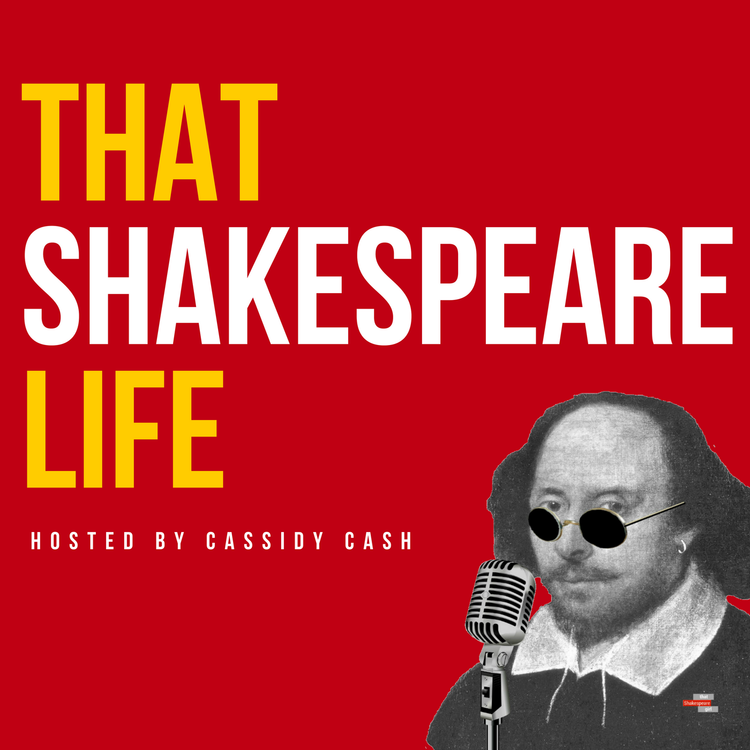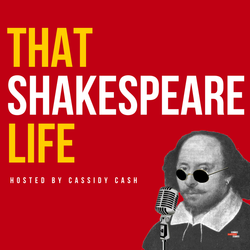Share

That Shakespeare Life
Christmas Carols and Madrigals for Shakespeare's Lifetime
During the reign of Elizabeth I, which was 1558-1603 and spans most of Shakespeare’s lifetime, England was experiencing the English Renaissance, a time when all forms of art were seeing a shift in popularity, but music, in particular moved from being something you would hear only in a church to being popular at more secular events. In fact, not only did Elizabeth I herself enjoy playing music, but as an art form, music was widely applied in early modern plays, like those of William Shakespeare, for both comedies and tragedies as a way to heighten the drama, almost exactly like what you think of as a movie soundtrack today. While instrumental music like that of the viringal or the lute were popular, one particular form of vocal performance known as the madrigal rose to prominence in early modern England as an adaptation of earlier Italian poetry set to music, which English composers transformed into a uniquely English genre. The madrigal became a popular way to celebrate major events, including Christmas celebrations, for Shakespeare’s lifetime. Here today to share with us the history of the madrigal is our guest, historian, and Early music specialist, Tasmin Lewis.
More episodes
View all episodes

402. “What Masque? What Music?” Ben Jonson & the Art of Court Spectacle
32:07||Ep. 402"Say, what abridgement have you for this evening? What masque? what music? How shall we beguile The lazy time, if not with some delight?" — A Midsummer Night’s Dream, Act V, Scene 1 There are over a dozen mentions of masques, masquers, and masquing in Shakespeare's plays, and when it came to masques in England for the 16-17th century, no one did them better than Ben Jonson, who was known for staging truly spectacular feats of gradeur at the court of James I. Our guest is Martin Butler, Professor of Renaissance Drama at the University of Leeds, Fellow of the British Academy, and General Editor of the Cambridge Works of Ben Jonson. He has written extensively on early modern drama and Jonson’s masques in particular, including how these productions functioned as political texts, cultural events, and artistic achievements. Martin joins us today to help us explore what a masque was exactly, how masques are different from a play, and why it was that Jonson's masques were so special.
401. A Royal Christmas with James I
57:14||Ep. 401Merry Christmas! This holiday season, we’re taking a trip back to one of the most extravagant Christmas celebrations of Shakespeare’s lifetime—the Christmas of 1603, when the newly crowned James I hosted his first royal festivities as King of England. The court was alive with feasting, pageantry, and opulent merrymaking. It was a moment of political transition, and James made sure his first Christmas made a powerful impression. The newly renamed King’s Men, Shakespeare’s company, performed for the court, securing their new royal patronage. Alongside these performances were dazzling masques, intricate entertainments, and diplomatic displays designed to cement James’s image as both a unifier and a sovereign of grandeur. This week, our guide through the glittering halls of Whitehall Palace in the winter of 1603 is Martin Wiggins, Senior Research Fellow at the Shakespeare Institute, Stratford Upon Avon, author of British Drama 1533–1642: A Catalogue, and President of the Malone Society. Today, Martin joins us to share what made this holiday season so historically important, how theater helped James define his kingship, and what the royal court’s festivities can teach us about Shakespeare’s world. Stay with us—we’re about to unwrap a Christmas filled with drama, diplomacy, and theatrical delight.
400. Anne of Denmark: The Queen Who Transformed Shakespeare’s World
28:48||Ep. 400Discover how Anne of Denmark shaped the culture of the Stuart court—from dazzling masques and groundbreaking stagecraft to political influence, artistic patronage, and a powerful performance legacy that helped define the world Shakespeare lived in. In this episode, Clare McManus joins us to explore how Anna’s identity, her innovations in court performance, and her role as a cultural force reveal a very different picture of queenship in early modern England.
399. "You dissentious rogues..." The Language of 16thC Thieves
33:34||Ep. 399In Shakespeare’s play Henry IV, Part 1, Falstaff declares on more than one occasion, “I am a rogue.” Several exchanges between Falstaff, Henry V, and others like Hostess Quickly and Doll Tearsheet, see characters throwing the word “rogue” back and forth as both an insult and a badge of honor.The term connects to a real form of slang underworld language known as rogue cant. Which was a secret, cryptic lexicon, spoken and understood only by criminals. Falstaff and his companions are the closest depictions of criminals in Shakespeare’s works. Their roguish behavior includes gathering at the Boar’s Head in Eastcheap to plan their crimes and divide their spoils. By choosing to use the word “rogue,” Shakespeare was deliberately connecting his characters to the real criminal underworld of 16th-century England that trafficked in this mysterious and coded language.To introduce us to this rogue cant, and to help us unlock the hidden meanings of these words so that we can better understand the culture that produced them, we are excited to welcome Ari Friedlander back to the show.Ari joins us today to take a closer look at rogue cant: where the words came from, how they were used, and what they reveal about Shakespeare’s world.
398. Arthurian England: How the Tudors Used Myth to Build a Nation
37:51||Ep. 398When we think of King Arthur, many of us imagine medieval romance—knights in shining armor, enchanted swords, or chivalric quests. But for the Tudors, Arthur wasn’t just storybook material. In the 16th century, Arthurian legend was a political tool, a national symbol, and—for some—an actual piece of English history. From Henry VII naming his heir “Prince Arthur,” to Elizabeth I being welcomed at Kenilworth with Lady-of-the-Lake imagery, the Tudors used Arthurian myth to define their dynasty, elevate their authority, and shape the emerging idea of English nationalism.This week, we’re exploring how Arthur, Merlin, and the world of Geoffrey of Monmouth were reinvented for a new age of politics, performance, and propaganda. Our guest, historian Andrew, walks us through royal pageants, literary allegory, and visual symbols that connected the Tudor monarchy to a heroic—and sometimes ominous—legendary past.
396. Gratitude, Diplomacy, and Deer at the First Thanksgiving
27:41||Ep. 396In November 1621, two communities—Wampanoag and English—came together at the edge of Patuxet for a shared harvest meal. While today we call this moment “The First Thanksgiving,” the historical reality is far richer and more culturally complex than the simplified story many of us grew up hearing.In this week’s episode, we explore this early moment of connection with Malissa Costa (Mashpee Wampanoag) and Richard Pickering (Plimoth Patuxet Museums). Together, they guide us through the world of the Wampanoag in the early 17th century—what they wore, how they prepared deerskin through traditional brain-tanning methods, how diplomacy often involved gift-giving, including venison, and what agricultural knowledge they shared with the English that ultimately saved lives.Rather than a single act of generosity, the 1621 harvest feast emerges as a meeting point of two sophisticated cultures—each with its own traditions of giving thanks, diplomacy, and seasonal celebration. As we step into this history, we learn how deeply both communities valued gratitude, relationship, and the generosity of the land.
396. The Slippery History of Eels in Shakespeare's England
46:18||Ep. 396When we imagine Elizabethan dining tables, we might picture roast meats, trenchers of bread, or tankards of ale. But lurking beneath the surface of rivers, marketplaces, and even the economy itself was a creature so valuable that it could pay rent, feed a nation, and still appear in Shakespeare’s humor — the eel.Eels once filled England’s rivers in such massive quantities that they became a crucial source of protein for the poor and a delicacy for the wealthy. They appear in legal documents, household accounts, market records, and yes — in Shakespeare’s plays. In Love’s Labour’s Lost, Don Adriano says:“What, that an eel is ingenious?” — Love’s Labour’s Lost (I.2)Today we’ll discover just how ingenious eels really were.This week, I’m speaking with Dr. John Wyatt Greenlee — medievalist, cartographic historian, and the internet’s favorite eel enthusiast — to explore the culinary, economic, and cultural world of eels in Shakespeare’s England. From eel rents and floating aquarium-ships to eel pies and insult comedy, we’re diving into how this slippery fish shaped daily life in the world Shakespeare lived in.
395. Gallant Fellows and Their Feathered Hats
19:09||Ep. 395In All’s Well That Ends Well, a character is described as “That with the plume: ’tis a most gallant fellow” (III.5), and in Love’s Labour’s Lost, the Princess of France mockingly asks, “What plume of feathers is he that indited this letter?” (IV.1), revealing how feathers could both elevate and satirize their wearer. Feathers might seem like a simple decoration today, but in the 16th and early 17th centuries, feathered clothing—especially feathered hats—spoke volumes about a person’s status, identity, and even their participation in the expanding global economy. To better understand the culture behind feathers in clothing for Shakespeare’s lifetime, we're sitting down this week with Professor Ulinka Rublack, whose article Befeathering the European investigates the history of feathers in clothing, to help us explore where the feathers come from, what they looked like, and how they were used.
394. The Venetian Doctor Who Turned ‘Hot’ and ‘Cold’ Into Numbers
25:09||Ep. 394In 1612—just one year after Shakespeare wrote The Tempest—Venetian physician Santorio Santori transformed Galileo’s simple thermoscope into the world’s first thermometer by adding a calibrated scale and sealing the device. His invention marked the birth of quantified medicine, turning vague sensations of “hot” and “cold” into measurable data that could guide treatment. In this episode, historian of medicine Dr. Fabrizio Bigotti joins us to explore Santorio’s remarkable innovations, how they predated Galileo’s own instruments, and why this quiet inventor deserves recognition as the true father of the thermometer.